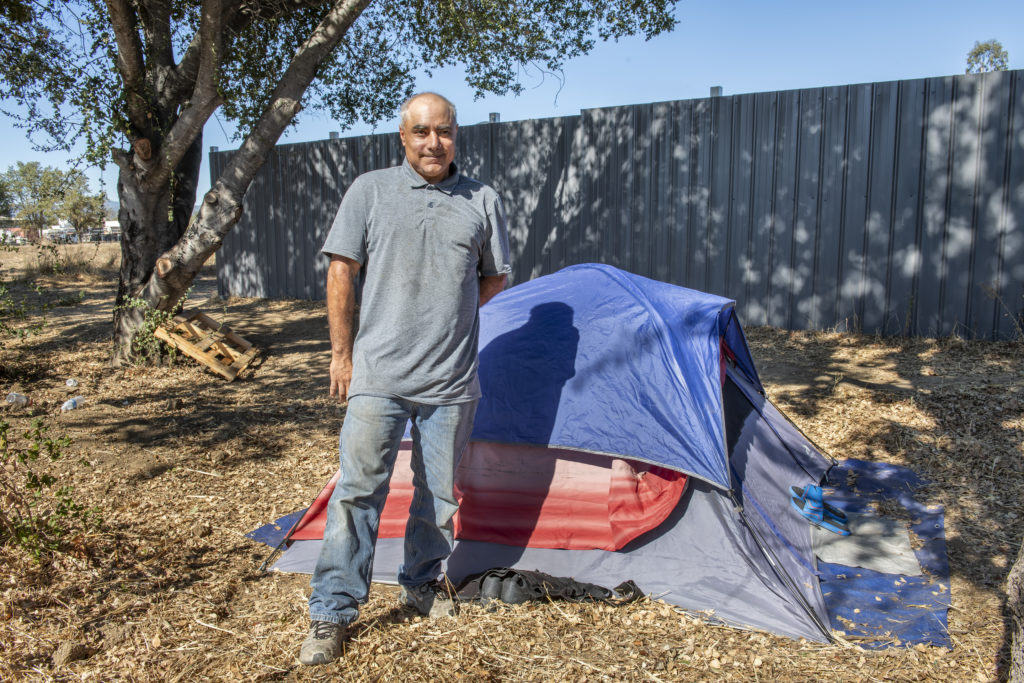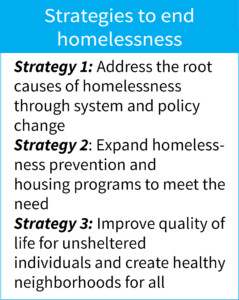Guest column by Liliana Kilmer: City should join the Community Plan to End Homelessness
Plan is not a quick panacea but offers a path to solving the homeless crisis in Santa Clara County.

Photo courtesy Kirsti Fatania-Bassendine
Tony, a homeless man, lives in a tent near a creek in Gilroy.
By Liliana Kilmer

Liliana Kilmer
After a long week of strenuous school work and no time for breaks, my friends and I decided to go to a McDonald’s restaurant in Gilroy — just a few teenage girls and their McNuggets. In the line for our food, we saw an old man who looked much like a skeleton.
Seeing his satchel in one hand and a shredded blanket in the other, my friends and I immediately felt the urge to provide this man with cash to purchase food to get him through the night. We collected enough money between the three of us to buy him a burger and gave him the money. It’s little things like that that people like ourselves often take for granted.
Although our lives and the way we live them might be vastly different, all humans have one thing in common: the need for essential resources to survive. If the city of Gilroy were to join the Community Plan to End Homelessness, we would be able to provide unsheltered people with the resources needed to survive.
 The Community Plan to End Homelessness is not a quick panacea but offers a path to solving the homeless crisis in Santa Clara County. The 2020 version builds upon the 2015 plan and is based on the input of more than 8,000 community members, including service providers, businesses, people who have experienced homelessness, elected officials, and concerned citizens.
The Community Plan to End Homelessness is not a quick panacea but offers a path to solving the homeless crisis in Santa Clara County. The 2020 version builds upon the 2015 plan and is based on the input of more than 8,000 community members, including service providers, businesses, people who have experienced homelessness, elected officials, and concerned citizens.
“The purpose of bringing the plan to cities for endorsement is for the public awareness and the importance of having a shared understanding of the problem and what needs to be done to combat it, with everyone pulling in the same direction,” said Jan Bernstein-Chargin, an advocate for the homeless who sits on the board of the nonprofit Destination Home, which created the plan.
Instead of simply throwing money at the problem, the program would tackle the issue at the source, rather than continuously spending valuable resources on the superficial aspect of the matter.
As a member of the Gilroy and Morgan Hill communities who has lived here my entire life, it saddens me to watch our beautiful towns become stained by the impacts of homelessness.
Now more than ever, it’s vital we solve the issue as quickly as possible. There are children growing up in neighborhoods where they see people living in tents. That is not normal, and that is not OK. We have watched the numbers of homeless rise substantially. Although the numbers of Santa Clara County’s homeless population for 2021 are not known, we are able to compare the 2017 to 2019 numbers.
 Data collected in the 2017 Homeless Census and Survey shows the number of homeless individuals identified was 722, which made Gilroy the second highest in the homeless population in the county after San Jose. The numbers of homeless people in Gilroy and Morgan Hill actually declined from 2017 to 2019.
Data collected in the 2017 Homeless Census and Survey shows the number of homeless individuals identified was 722, which made Gilroy the second highest in the homeless population in the county after San Jose. The numbers of homeless people in Gilroy and Morgan Hill actually declined from 2017 to 2019.
The county did not do a point-in-time count this year because of the pandemic. The counts are done every two years. However, visibility has gone up in the South Valley, as policing of business districts has driven more people into larger encampments and CDC guidelines prohibit encampments from being “swept.”
We must not place blame on anyone for the homeless crisis. Rather, we should find a solution as quickly as we can. The 2015-2020 plan permanently housed 14,132 individuals in Santa Clara County. More than 96 percent of those housed in the course of those five years remained housed for a minimum of 12 months. We saw progress happening and promises made that are being fulfilled.
 The 2020-2025 plan has three strategic points:
The 2020-2025 plan has three strategic points:
Strategy 1 aims to prevent people from becoming homeless by addressing the causes of homelessness, and providing intervention early, before people hit the street.
Strategy 2 continues the solutions of the first plan, creating and providing housing for the people who are now homeless, with support services for those who need them.
Strategy 3 addresses conditions in the community and on the street with investing in temporary housing, outreach, and shelter capacity to reduce the harms caused by homelessness to individuals and communities.
As a member of the community, I urge support for Gilroy to join the Community Plan to End Homelessness.
Liliana Kilmer is a senior at Christopher High School. She is an intern with Gilroy Councilmember Zachary Hilton.
- Guest column by Tim Davis: Two Gilroy nonprofits join forces to help those in need - April 17, 2024
- Your Retirement … with Marisa Otto: Do you know how your retirement income is getting taxed? - April 17, 2024
- Guest column by Jaci Muro: Gilroy Foundation supports young people with college scholarships - March 30, 2024
